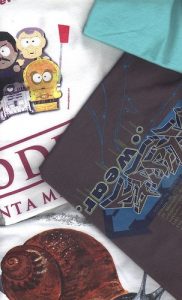Screen Printing
Screen printing is the traditional printing method for t-shirts and is the best way of printing onto cotton clothing. It is the ideal method for large designs and is Indigo’s technique of choice for t-shirt printing because of the quality it produces. When you buy a printed tee in a high-street shop, this has most likely been screen printed.
The screen printing process
 Screens are made by putting a chemical emulsion on a mesh surface. Vector artwork is taken from Adobe Illustrator or Corel Draw and printed out on a film type paper or vellum. The screen is then exposed on a light table with the artwork under it. The light solidifies the chemicals around the design, and where the light failed to pass through, the chemical breaks down. The screen is then rinsed out and what is left is the area where the light hit.
Screens are made by putting a chemical emulsion on a mesh surface. Vector artwork is taken from Adobe Illustrator or Corel Draw and printed out on a film type paper or vellum. The screen is then exposed on a light table with the artwork under it. The light solidifies the chemicals around the design, and where the light failed to pass through, the chemical breaks down. The screen is then rinsed out and what is left is the area where the light hit.
The shirt is placed on a platen and each screen swings around over the top of the shirt. The screen is then brought down and placed on top of the shirt. A squeegee is then pulled over that screen’s ink colour pushing the ink onto the shirt fabric. The screen is carefully lifted off of the shirt (if the shirt moves or is stretched, the next colour will be out of registration). The platen with the shirt is moved under a flash unit to dry. The shirt platen is brought back and the next colour screen is swung over the top of it.
When screen printing, one colour is applied at a time and therefore the cost increases with each additional colour applied. A separate screen is required for each colour, and hence, screen charges may be uneconomical if only a small quantity of clothing is required.
The quality of screen printing
Screen printed garments wash well, and should not be confused with heat transfer printing which does not look as good or last so well. Many t-shirt printing shops use this cheaper method rather than screen printing. You may also hear of screen printing be refereed to as silk screening or silkscreen as screen meshes used to be made out of silk.
Compare screen printing with other printing methods
Print prices
When you place an order for screen printed clothing there are two charges:
1. Setup
The first is a setup charge which covers the cost of having the design made into a screen. This charge is ‘one off’ as the screen is stored for future use. Therefore, if you wanted to place another order in the future with the same design there would be no setup charge.
Screen print setup is charged at £20 per screen (ex VAT). One screen is required for each different design, and different screens are required for each colour printed, and each different location of printing. For example, a one colour front and back print requires two screens if the design on the front is different to the design on the back.
2. Per screen/per colour
The second charge is a ‘per screen’ charge which applies to each item that is customised. This charge basically covers the cost of labour, materials and our other manufacturing overheads. The per screen charge is directly based on the number of items to be printed with the same design and applies to each screen.
Standard lead time is approx. 5 to 10 working days. Call or email for long lead time pricing. High volume prices (500) are sometimes negotiable. *Prices correct at time of publishing.
Alternatives printing methods
DTG (Direct to Garment) is a recent development in the textile printing industry which produces a high quality finish similar to that of screen printing. It is ideal for short runs and prints that normally would require many screens.
Find out more about screen printing
- For an exact quote based on your design, please call or email or fill out our online quote form
- Indigo Clothing also embroider garments. Find out more about embroidery.
- Some interesting extra reading:
